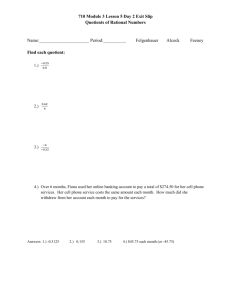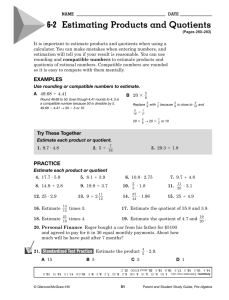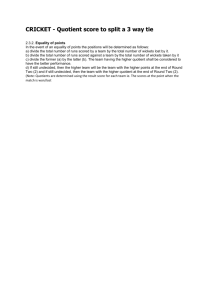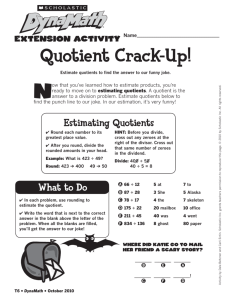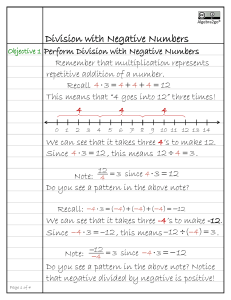WHAT IS THE SIZE OF MY PRODUCT OR QUOTIENT? PRODUCTS
advertisement
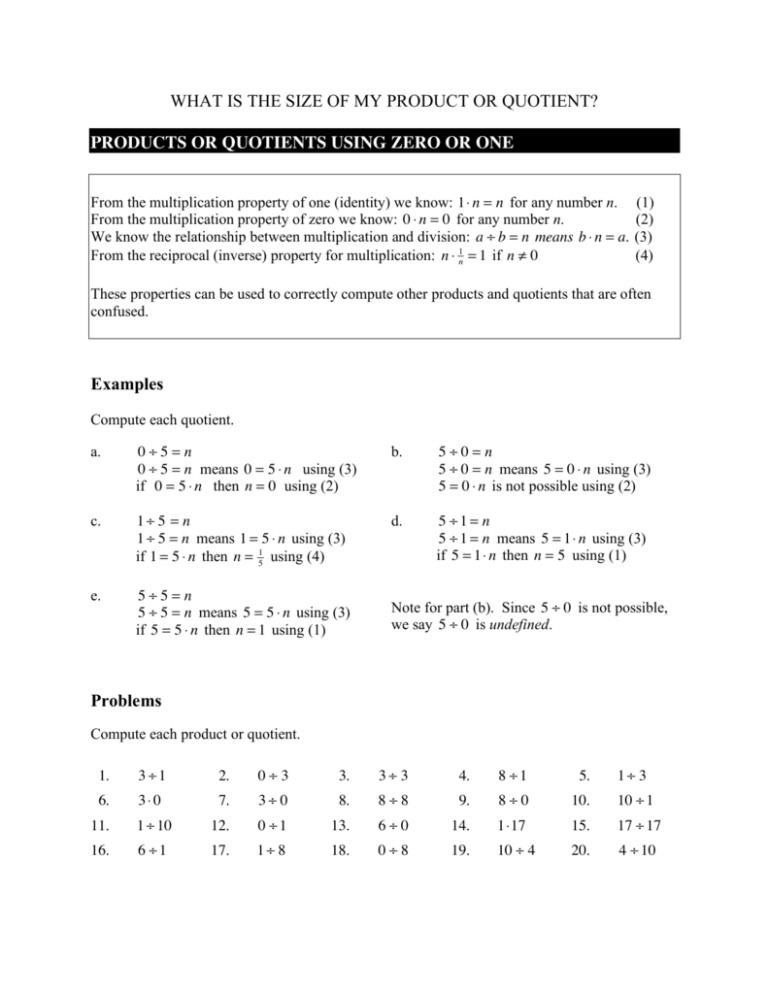
WHAT IS THE SIZE OF MY PRODUCT OR QUOTIENT? PRODUCTS OR QUOTIENTS USING ZERO OR ONE From the multiplication property of one (identity) we know: 1! n = n for any number n. From the multiplication property of zero we know: 0 ! n = 0 for any number n. We know the relationship between multiplication and division: a ÷ b = n!means!b ! n = a. From the reciprocal (inverse) property for multiplication: n ! 1n = 1 if n ! 0 (1) (2) (3) (4) These properties can be used to correctly compute other products and quotients that are often confused. Examples Compute each quotient. a. 0 ÷ 5 = n! 0 ÷ 5 = n! means 0 = 5 ! n! using (3) if 0 = 5 ! n! then n = 0! using (2) b. 5÷0=n 5 ÷ 0 = n means 5 = 0 ! n using (3) 5 = 0 ! n is not possible using (2) c. 1÷ 5 = n 1 ÷ 5 = n means 1 = 5 ! n using (3) if 1 = 5 ! n then n = 15 using (4) d. 5 ÷1= n 5 ÷ 1 = n means 5 = 1! n using (3) if 5 = 1! n then n = 5 using (1) e. 5÷5=n 5 ÷ 5 = n means 5 = 5 ! n using (3) if 5 = 5 ! n then n = 1 using (1) Note for part (b). Since 5 ÷ 0 is not possible, we say 5 ÷ 0 is undefined. Problems Compute each product or quotient. 1. 3÷1 2. 0÷3 3. 3÷ 3 4. 8 ÷1 5. 1÷ 3 6. 3! 0 7. 3÷ 0 8. 8÷8 9. 8÷0 10. 10 ÷ 1 11. 1 ÷ 10 12. 0 ÷1 13. 6÷0 14. 1!17 15. 17 ÷ 17 16. 6 ÷1 17. 1÷ 8 18. 0÷8 19. 10 ÷ 4 20. 4 ÷ 10 PRODUCT AND QUOTIENTS USING FRACTIONS BETWEEN ZERO AND ONE; GREATER THAN ONE It is important to understand that when multiplying or dividing any positive number by a positive fraction whether the answer should increase or decrease. The properties listed previously will help to justify the reasons for the size of the answer. Examples Justify whether the product or quotient is larger or smaller than the number in parenthesis. a. 1 2 ! (4) = n 1 2 ! 4 = n means if 1 2 = n 4 b. 1 2 = n 4 1 2 = if 1 12 = 2 4 Similar problems show that multiplying by a number between zero and one causes the product to be smaller. c. 1 12 ! 4 = n means 1 12 = using (3) then n = 2 since (4) ÷ 2 = n 4 ÷ 2 = n means 4 = 2 ! n using (3) if 4 = 2 ! n then n = 2 since 2 ! 2 = 4 Similar problems show that dividing by a number greater than one causes the quotient to be smaller. 1 12 ! (4) = n n 4 n 4 using (3) then n = 6 since 6 4 = 1 12 Similar problems show that multiplying by a number greater than one causes the product to be larger. d. (4) ÷ 12 = n 4 ÷ 12 = n means 4 = 12 ! n using (3) if 4 = 12 ! n then n = 8 since 1 2 !8 = 4 Similar problems show that dividing by a number between zero and one causes the quotient to be larger. Remember that we are just considering products involving positive numbers. For concrete diagrams illustrating products and quotients with fractions see topics #12 and #19 of the Skill Builder Booklet. Note that since decimals are fractions, all of the previous information applies to decimals also. Problems Without doing any computations, determine if the product/quotient is larger or smaller than the number in parenthesis. 1 43 ! ( 23 ) 22. (8) ÷ (8.5) ÷ 100 25. 3 4 27. (0.25) ÷ 0.03 28. 30. 1 4 21. 24. ! ( 25 ) 31. 2 3 ! ( 2 23 ) (3 ) ÷ 1 ( )÷ 1 2 1 8 1 3 1 3 23. 0.24 ! (3.2) 26. ( 87 ) ÷ 1 12 29. 7.75 ! (0.04) 32. (1) ÷ 0.0025 Without doing any computations, place these numbers in order from least to greatest. 33. 35. 37. 45,!!45 ÷ 43 ,!!45 ! 43 1 12 ,!! 23 !1 12 ,!!1 12 ÷ 23 1 1 1 1 1 3 ,!! 3 ÷ 2 ,!! 2 ! 3 34. 36. 72 !1.25,!!72 ÷ 1.25,!!72 2.4,!!0.3 ! 2.4,!!2.4 ÷ 0.3 38. 2 3 ,!! 23 ÷ 1 15 ,!!1 15 ! 23 Answers 1. 3 2. 0 3. 1 4. 8 6. 0 7. NP 8. 1 9. NP 10. 10 15. 1 11. 1 10 12. 0 13. NP 14. 17 17. 1 8 18. 0 19. 10 4 16. 6 21. 24. 27. 30. 33. 35. larger smaller larger smaller !45 ! 43 ,!!45,!!45 ÷ 43 ! 23 !1 12 ,!!1 12 ,!!1 12 ÷ 23 37. 1 2 ! ,!! ,!! ÷ 1 3 1 3 1 3 1 2 22. 25. 28. 31. larger smaller smaller larger 5. = 5 2 20. 23. smaller 26. smaller 29. smaller 32. larger !72 ÷ 1.25,!!72,!!72 !1.25 34. 36. 0.3 ! 2.4,!!2.4,!!2.4 ÷ 0.3 38. 2 3 ÷ 1 15 ,!! 23 ,!!1 15 ! 23 1 3 4 19 = 2 5
